

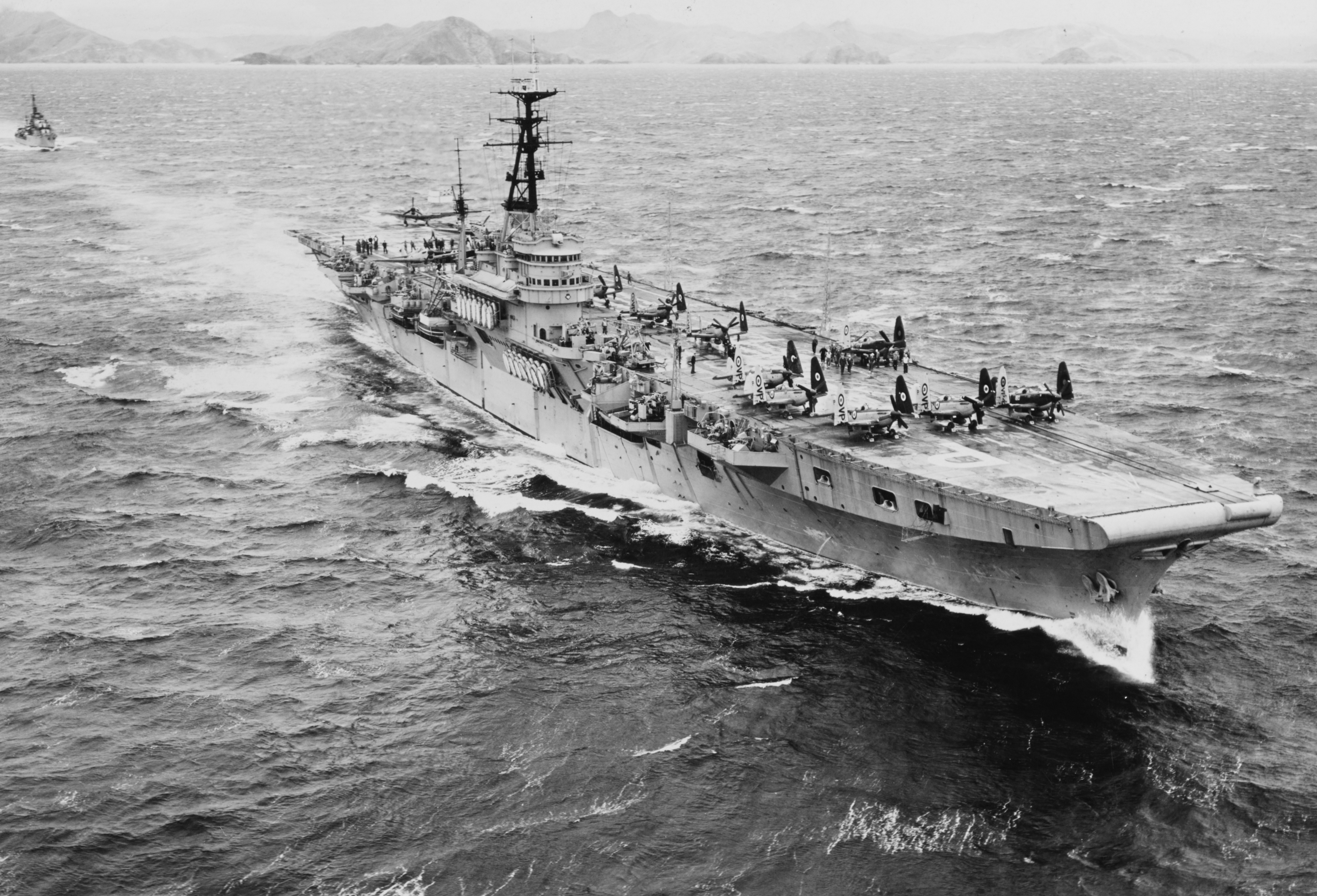
Although the Hawker Sea Fury and Fairey Firefly Mk.5 have become synonymous with the Fleet Air Arm's contribution to the Korean War, when the conflict started on the 25th June 1950, the first British carrier to be deployed had much older types embarked. This carrier was HMS TRIUMPH and onboard was the 13th Carrier Air Group, consisting of 800 Naval Air Squadron equipped with the Supermarine Seafire F.R Mk.47 and 827 Naval Air Squadron with the Fairey Firefly F.R.Mk.1.
During the summer of 1950 HMS TRIUMPH was part of the 1st Aircraft Carrier Squadron, Far East Fleet, along with the carrier HMS UNICORN and the main part of this fleet, whose flagship was the famous cruiser HMS BELFAST (now moored in the Pool of London) was conducting a cruise of far eastern waters. They had just left Japan en route for Hong Kong when Communist North Korean forces commenced their assault over the 38th Parallel and into South Korea on the 25th June 1950. This passage to Hong Kong should have been the first leg of HMS TRIUMPH's passage back home to the UK in order to retire its elderly Seafires and Fireflies, but instead the fleet was immediately recalled to Japan and on the 29th June it was placed under the control of Vice Admiral C.T. Joy, the American Naval Commander in charge of operations on behalf of the United Nations in Korean waters.
Shortly afterwards they sailed from Japan to join up with the US 7th Fleet at Okinawa. Although there were two aircraft carriers assigned to the British Far East Fleet only one of them was operational as HMS UNICORN, which had also been due to return back to the UK, was only configured as a repair carrier; she would play a vital role by providing replacement aircraft and would shuttle between Royal Naval Air Station Sembawang in Singapore, which was the main Royal Navy aircraft maintenance yard in the far east and the newly established forward operating base for the British fleet established at Sasebo in Japan, a duty it would continue to fulfil until the end of the Korean War in support of successive operational carriers.
After reaching Okinawa the British ships joined up with their American allies to form Combined Task Force 77, with the British contingent being known as TG 77.5 and the American carrier in this force was USS VALLEY FORGE, which carried up to eighty Grumman Panther jets, Douglas Skyraiders and Vought Corsairs to compliment the twenty four Seafires and Fireflies on board HMS TRIUMPH! This fleet then set sail for the Korean coast and during the journey the Fireflies flew anti-submarine patrol sorties whilst both British types flew around the US Navy ships to identify themselves to the American anti-aircraft gunners to try and avoid any so called `friendly fire' incidents from occurring.
In the early hours of the 3rd July 1950 the first strike sortie over Korea was flown when 800 NAS pulled out all of the stops to produce its entire compliment of twelve Seafire F.R.47s, which along with nine Firefly F.R.1s made a rocket attack against the North Korean airfield at Kaishu, where they destroyed hangars and buildings but unfortunately no aircraft were present and the only casualty was a Seafire, which returned with serious damage to its engine caused by debris thrown up by its own rockets. The Americans struck at another airfield at Heiju and had better luck as they managed to destroy two North Korean Yak 9 fighters in the air and eight other aircraft on the ground, as well as causing damage to many airfield buildings, but one Corsair flying a CAP (Combat Air Patrol) over the fleet had to ditch when its engine caught fire. As a matter of interest, the two Yak 9`s that had been shot down were dispatched by Grumman Panthers from VF-51 who were flying top cover for the strike and these were the first kills ever to be scored by US Navy jet fighters.
Not to be outdone by 800 NAS, the next day 827 NAS also managed to field its full complement of twelve Fireflies for operations and alongside seven Seafires they were involved in various rocket and cannon attacks on army barracks, bridges, gun positions and vehicles, including two dangerous flak lorries but in return one of the Fireflies received flak damage to its fuselage and a Seafire had one of its wing mounted auxiliary `combat fuel tanks' holed by flak, whilst another Firefly had to make a forced landing using only one wheel when the other failed to lower. On the same day American aircraft from the USS VALLEY FORGE destroyed a couple of gunboats, as well as attacking railway bridges, locos and tunnels but they suffered the loss of nine aircraft when a flak damaged Skyraider missed the barrier upon landing and careered into the deck park. They also lost their Sikorsky HO3S-1 (S-51 Dragonfly) air sea rescue helicopter which was forced to ditch after engine failure.
During these first two days of action it had become obvious that during combined fleet operations the longer ranged aircraft used by the US Navy were more suitable for attacks against land based targets as the fleet was forced to sail closer to shore in order to launch the shorter ranged British types; so it was agreed that the British aircraft would instead provide defensive cover for the fleet whilst the Americans would mount operations over Korea. Under the circumstances this was a common sense decision, especially as the Seafires were by far the best defensive fighters in either fleet anyway, so they would conduct Combat Air patrols (CAP) sorties while the Fireflies flew anti-submarine (A/S) patrols. While this role would at first seem to be less important it was still vital as the North Korean Navy possessed a credible submarine threat and their small air force was still offensively active; the destroyer HMS COMUS was to suffer an attack by two North Korean IL-10 Sturmoviks whilst it was operating away from the main fleet and other ships were also attacked at various times.
To further reinforce how important the British aircraft were to the UN fleet at this time, HMS TRIUMPH's Ships Flight Supermarine Sea Otter amphibian (JM960) named `Neptune’s Daughter' proved vital, and this was especially so on the 19th July when an American Corsair pilot was forced to ditch in extremely rough seas off Wonsan on the Korean coast after his aircraft had received flak damage. The Sea Otter, flown by Lt. Cdr. P. Cane and his crewman Chief Petty Officer Aircrewman G. O`Nion carried out a long range search to find and retrieve him but whilst landing on the rough sea it suffered a damaged float and at one time almost resembled a crash diving submarine due to the size of the waves. Nevertheless, they got the American pilot aboard and managed to take off again, earning Lt. Cdr. P. Cane a well-deserved American Air Medal and Chief Petty Officer Aircrewman G. O`Nion received a mention in despatches.
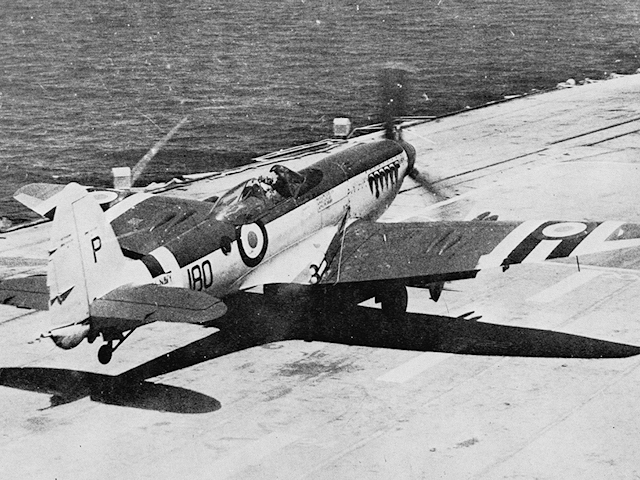

Whilst the protection of the fleet might seem unglamorous, it continued in all weathers around the clock, resulting in a high sortie rate onboard HMS TRIUMPH, averaging twenty-seven CAP and ten A/S patrols per day so with such intensive flying it was not long before landing accidents started to occur. The Seafire was particularly prone to damage to its rear fuselage in a heavy landing which tended to wrinkle the fuselage skin and a special micrometer type gauge was used to determine whether the wrinkles were sufficient to ground an aircraft or for it to continue flying. Upon reaching a certain level the `wrinkled' Seafires were supposed to be grounded on the spot and returned to Britain to be re jigged, but the air engineering officer and his team stretched the rules slightly under wartime conditions and managed to keep many of them flying. However as soon as HMS TRIUMPH was relieved of its operational duties off Korea and peacetime rules returned the entire Seafire compliment was grounded due to excessive wrinkling!
Throughout July and into August the Seafires and Fireflies continued their defensive duties with four Seafires being written off in landing accidents but another was shot down by a `supposedly friendly' US B29 Superfortress on the 28th July. This occurred after a formation of unidentified aircraft had been spotted on radar screens approaching the fleet so a flight of CAP Seafires were sent to investigate. After identifying the formation as `friendly' United States Air Force B-29s the British fighters flew alongside them but Seafire VP473 ‘176/P’ flown by Commissioned Pilot White was then hit by gunfire from the American aircraft which caused its rear fuselage fuel tank to immediately burst into flames and even though White managed to roll his Seafire onto its back and then bale out, in the short space of time it took to do this he had already suffered serious burns to his face, arms and shoulders. He landed safely by parachute into the sea, but as it was far too rough even for the Sea Otter to attempt a rescue, he had to remain in the water for over an hour before being eventually picked up by a US destroyer. When the incident was reported to the United States Air Force the only reply that the Royal Navy received was that `Next time the British should not fly too close'! Some things it seems never appear to change and perhaps the `Superfort' crews in this case were ardent Republicans!
There had already been incidents before this of Americans mistaking the unfamiliar British Seafire for a North Korean Yak 9 so by the start of July all of the Seafires and Fireflies had been painted with black and white `D Day type' stripes on their wings and rear fuselage to try and ease the identification problems caused by these none US built types but obviously they did not help in this case and there were still problems.
During August the British ships detached away from the Americans to concentrate their efforts within a combined Commonwealth Task Force which would deal with the West Coast of Korea while the Americans became responsible for the East Coast and the main task of each fleet was the blockade of enemy ports and attacking enemy shipping. The Seafires and Fireflies could now be used offensively again and their main role was to fly armed reconnaissance sorties over ports and searching for camouflaged shipping within the many confined waterways in the area. The first sorties were flown on the 13th August when two Seafires photographed the ports of Mokpo and Kunsan and shot up two small ships whilst another sortie was flown later to photograph Inchon. Next day the main North Korean naval base at Chinnampo was photographed and three ships were found moored out in the estuary so even though extremely heavy anti-aircraft fire was encountered a strike was immediately arranged against these ships using six Seafires and six Fireflies, all armed with 60lb rockets. These took off in the afternoon to attack what turned out to be a camouflaged minesweeper, a 2,000 ton freighter and an 800 ton coaster and all three vessels were left substantially damaged while all aircraft returned safely. More armed reconnaissance sorties were flown the following day as well as a naval gunfire support spotting sortie in conjunction with the cruiser HMS JAMAICA and the aircrew’s proficiency in this role would later lead to it becoming something of a forte for the Seafire and Firefly men.
On the 19th August a particularly successful patrol of Fireflies came across a camouflaged 150-ton motor junk armed with a variety of heavy calibre anti-aircraft guns and they left it well ablaze after expending sixteen 60lb rockets on it after which they proceeded inland to attack a number of railway wagons, oil storage tanks and small coastal junks using their cannons. Over the next few days a Seafire provided spotting support for the destroyer HMS CONSORT which shelled a factory at Kunsan and a strike was made upon flak positions on the island of Wolmido while a flight of four Seafires were also sent on an armed reconnaissance in the area of Chinnampo but even though they followed the river as far as the North Korean capital Pyongyang where heavy anti-aircraft fire was encountered there were no worthwhile targets to attack. This was one of a number of long-range armed reconnaissance flights by the Seafires during this period and one even went as far as the Manchurian border.
Due to a succession of heavy landings caused by bad weather and tiredness some of the fuselage wrinkles on the Seafires were becoming a bit too large for comfort so the worst affected aircraft were withdrawn and used for spares which left only nine Seafires available for operations on HMS TRIUMPH but HMS UNICORN was also down to its last six replacements. The situation regarding the Fireflies was not much better and many of the replacements that had been scraped together from all over the far east for passage to Japan on UNICORN were found to be totally unserviceable as the rubber seals in their engines and hydraulics had rotted away whilst the aircraft were in storage in tropical conditions; some of them had been there since the end of WW 2.
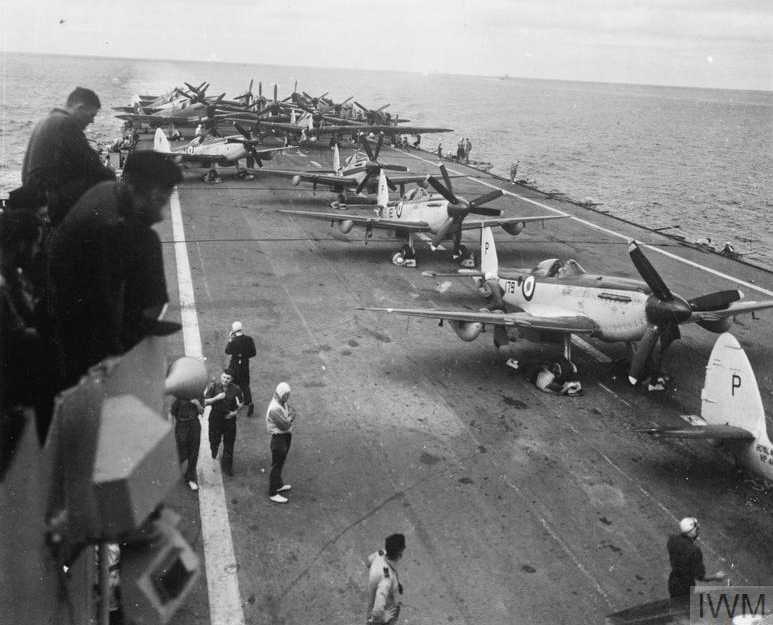
An unhappy incident occurred on the 29th August 1950 when Lt. Cdr. MacLachlen, the Commanding Officer of 800 NAS, became the only aircrew fatality of HMS TRIUMPHs entire Korean tour as he was mortally injured in a freak accident. He had been inside the operations room in the carrier's island when a Firefly (believed to have been PP433 flown by Lt Bridgeman) crashed into the barrier outside on the deck and fragments of its wooden propeller detached and flew through an opened scuttle (porthole) to hit him as he stood inside. He was later buried at sea with full military honours and the senior pilot; Lt. Cdr. Handley took over the Seafire squadron.
On the 30th August HMS TRIUMPH returned to Sasebo in Japan to replenish stores and receive the last six Seafires and eight Fireflies from HMS UNICORN, which were the least serviceable of all the replacements and as such had been held back until now for that reason. Unfortunately there were no other spare aircraft available in the entire far east, as the Seafire F.R.47 and Firefly Mk.1 were no longer regarded as front line types anymore and had been retired from every front line squadron in the Fleet Air Arm apart from the two that were actually fighting a war! As well as ferrying these aircraft the hangar decks of HMS UNICORN were also crammed with men of the 27th Infantry Brigade (1st Bn. Middlesex Regt, 1st Bn. Argyle and Sutherland Highlanders and 3rd Bn Royal Australian Regt) who had embarked at their base in Hong Kong and would soon be heading for the Pusan perimeter. With the British Army so heavily committed in Malaya, West Germany and the Middle East these were the only British troops available to serve in Korea until more units could be brought up to strength with the arrival of reservists in order to help form a British Commonwealth Division.
HMS TRIUMPH returned to Korean waters on the 3rd September. By now the situation in Korea was critical as UN troops had been pushed back so far by the North Koreans that they now only held a 60 square mile toehold at Pusan.
The aircraft recommenced operations straight away but the previously mentioned air attack by North Korean IL-10 Sturmoviks against HMS COMUS, which had holed the ships side and killed a rating, had only recently occurred, so the Seafires were retained for CAP duties while the Fireflies went on the offensive, flying armed reconnaissance sorties. Various small junks, pontoon bridges, sampans and motor cruisers were sunk, but the North Koreans were becoming savvy to the need to camouflage their shipping and a patrol of two Fireflies found three strange looking heavily vegetated islands which turned out to be heavily camouflaged North Korean gunboats, so they were then attacked and left heavily damaged. More naval gunfire spotting sorties were flown over the next few days by Seafires and Fireflies on behalf of HMS JAMAICA and HMS CHARITY against targets in Inchon and Kunsan. HMS TRIUMPH next sailed for the east coast to take over the vital job of supporting the UN forces in the Pusan perimeter from the US carriers USS VALLEY FORGE and USS PHILIPPINE SEA.
In an attempt to disrupt the North Korean supply lines the first sortie mounted in this new area was a strike by six Fireflies, with six Seafires as escort which launched at dawn on September 8th to attack targets of opportunity in the Wonsan area and this patrol flew south along the railway line looking for supply trains. They caught one which was then sprayed with cannon and rocket fire that caused extensive damage to the boxcars and blew up the loco whilst other patrols in the area that day attacked large concentrations of boxcars in the marshalling yards at Kowon and Yonghung and two railway tunnels, possibly with trains inside them, were totally blocked at both ends by rocket fire.
The constant strain of operations from TRIUMPH was by now having a major effect on the serviceability of the aircraft and the increased tempo of operations over the Pusan perimeter caused a further four Seafires to be grounded due to skin wrinkling, leaving only five available for operations.
Most of the Seafires grounded with excessively wrinkled fuselage's were in fact from the batch of replacement aircraft that had recently been received from UNICORN and as they had not been subjected to any over excessive treatment since arriving on board TRIUMPH it highlights the fact that they were in a pretty poor state to begin with.
To add to the availability problems one of the serviceable Seafires was lost when the pilot was forced to bail out when his hook failed to lower for landing and another was written off after it crashed on deck after landing with only one of its undercarriage legs down as the other had failed to lower. In addition, a Firefly was also badly damaged when it made a bad landing and bounced off the deck only to be held dangling over the side of the ship after its hook had engaged on an arrester wire.
A successful strike was flown by two Seafires and two Fireflies in bad weather against Koryu airfield on the 9th September which caused considerable damage but by now this was a maximum effort operation as only a handful of aircraft remained operational and the next day a US carrier arrived to relieve TRIUMPH. She returned to her temporary `home' port at Sasebo in order to prepare for a vitally important operation in support of the UNs campaign in Korea.
As already mentioned, the bottom of the replacement aircraft barrel had already been scraped clean by this stage and no further aircraft were available, especially as UNICORN was now undergoing a refit in Singapore.
As many of the duds as possible were repaired during the time in port bringing the total number of both types available for sorties to roughly twelve aircraft. Indeed, aircraft were so precious now that a newly arrived contingent of inexperienced replacement pilots were not allowed to be put onto the flying rota in case they `bent' an aircraft, and the importance of every sortie would have to be carefully considered before the take-off of an aircraft could be authorised.
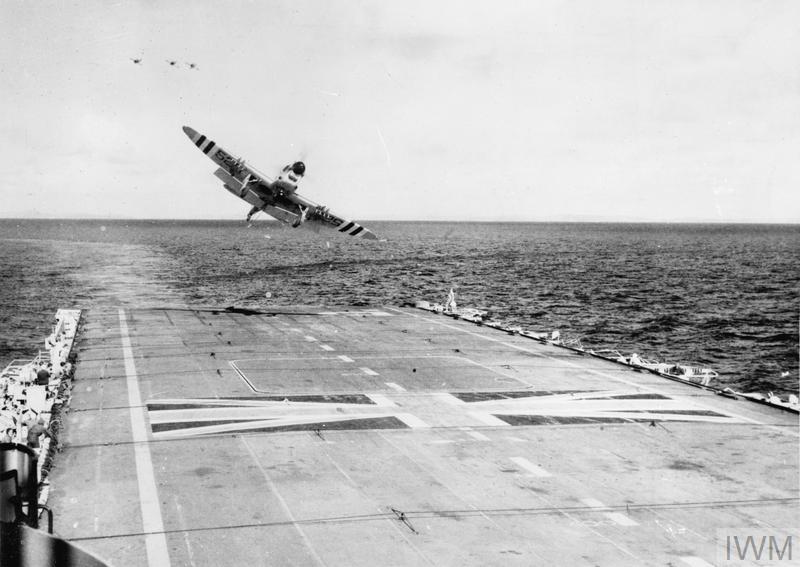
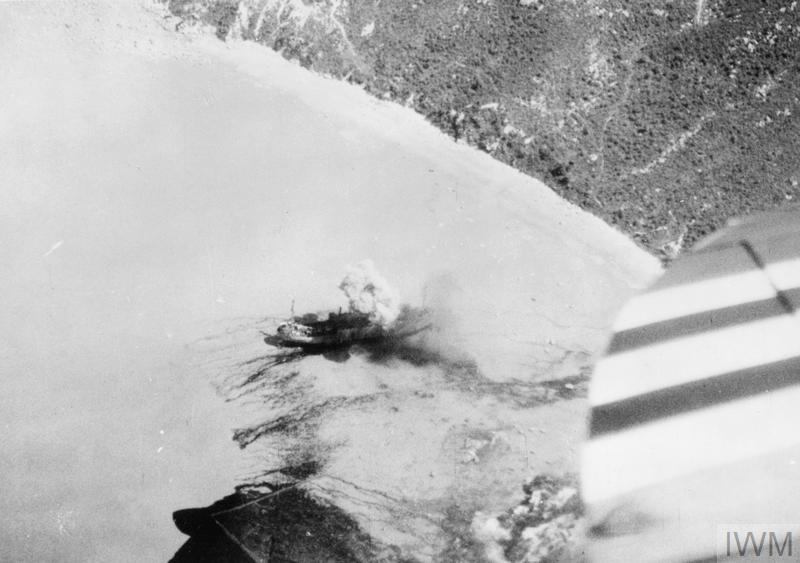
When HMS TRIUMPH sailed from Sasebo again she had been allocated to take part in Operation CHROMITE, the amphibious landing at Inchon; this would outflank the North Koreans who were besieging the occupants of the Pusan perimeter by landing well behind the front line in an attempt to threaten their exposed supply routes. The initial task of the Seafires and Fireflies was to provide local CAP and A/S cover for the convoy which was on its way from San Diego, USA carrying the US 1st Marine Division who would comprise the main assault force with 41 (Independent) Commando of the Royal Marines attached to them and once the convoy had been escorted to its holding area the British aircraft would then be released to conduct offensive patrols. The effectiveness of the British pilots at naval gunnery spotting had also not gone unnoticed and they would be the aircraft of choice for this role by warships of the US and British Commonwealth Navies during the landings to follow.
On the 13th September armed reconnaissance patrols were commenced along the Korean coast and on D-Day on the 15th September 1950 the Fireflies were fitted with 45-gallon drop tanks under each wing to give them extra endurance for their important naval gunfire support spotting task. With the Fireflies busy directing naval gunfire the Seafires were engaged throughout the day attacking targets of opportunity such as coastal shipping, troop movements and flak batteries in support of the 13,000 troops who would be landed ashore by nightfall. The day after the landings operations continued much the same although the airfield at Haeju was also attacked by Seafires and on the 17th September the North Korean Air Force put in its only appearance of the operation against the naval forces when a Yak 3 and an IL-10 Sturmovik mounted a dawn attack on the cruisers USS ROCHESTER and HMS JAMAICA. The Sturmovik dropped a bomb on the US ship which failed to explode and both enemy aircraft raked the British cruiser with cannon fire but whilst there was no return fire from the USS ROCHESTER the British gunners onboard HMS JAMAICA were much more on the ball and they shot the Sturmovik down.
For five more days operations continued at a steady tempo for HMS TRIUMPHs aircraft with Fireflies carrying out bombardment support sorties and the Seafires concentrating on CAP and rocket attacks against targets of opportunity; one of these attacks seriously damaged a 500 ton ship along with another similar sized vessel on a nearby slipway, other strikes damaged patrol boats and other supply vessels..
By September 19th there were only three Seafires and eight Fireflies left operational and the decision was taken on the 21st for HMS TRIUMPH to disengage and orders were received to return to the UK; her sister ship HMS THESEUS was due to arrive in theatre within a week carrying more modern Firefly A.S.Mk.5s and Sea Fury F.B.11s.
The crew and aircraft of HMS TRIUMPH had contributed a great deal to the opening stages of the Korean War, despite its elderly air group of Seafire F.R.Mk.47s and Firefly F.R.Mk.1s and the fact that the crew had been unexpectedly called into action just as they were expecting to return home to the UK at the end of a long deployment makes their efforts doubly outstanding. They had gone overnight from a peacetime cruise to a war footing and were at the end of an extremely long supply chain yet the maintenance ratings in the hangars continued to provide serviceable aircraft day in day out whilst the aircrews carried out their duties in the best traditions of their service with extreme professionalism.
Upon leaving for home Admiral Joy, the American Commander Naval Forces Far East sent the following message: -
To TRIUMPH
"On the departure of HMS TRIUMPH from the command of the Naval Forces Far East, I take pleasure in saying to the captain, the officers the flying personnel and the crew of this splendid fighting ship-WELL DONE. Your enthusiastic and effective efforts have contributed immeasurably to the United Nations cause in Korea. "
© 1999-2025 The Royal Navy Research Archive All Rights Reserved Terms of use Powered byW3.CSS
Comments (12)
Looks like my late father Ronald Henry also served on the Triumph 26 April 49 to 14 Nov 50. He looked after the radio equipment
In December 1945 the British Pacific Fleet was disbanded and its forces were absorbed into the East Indies fleet. In 1952 The East Indies Fleet was renamed the Far East Fleet. After the Second World War the East Indies Station continued as a separate command to this one until 1958.